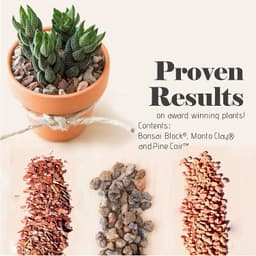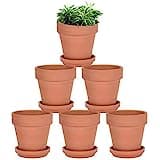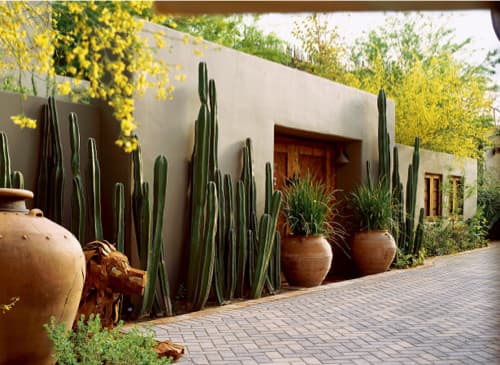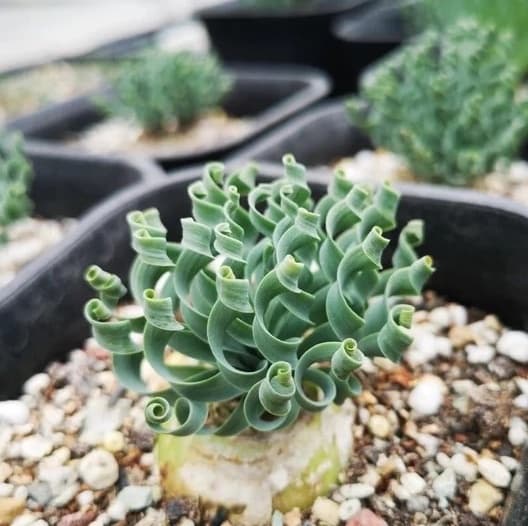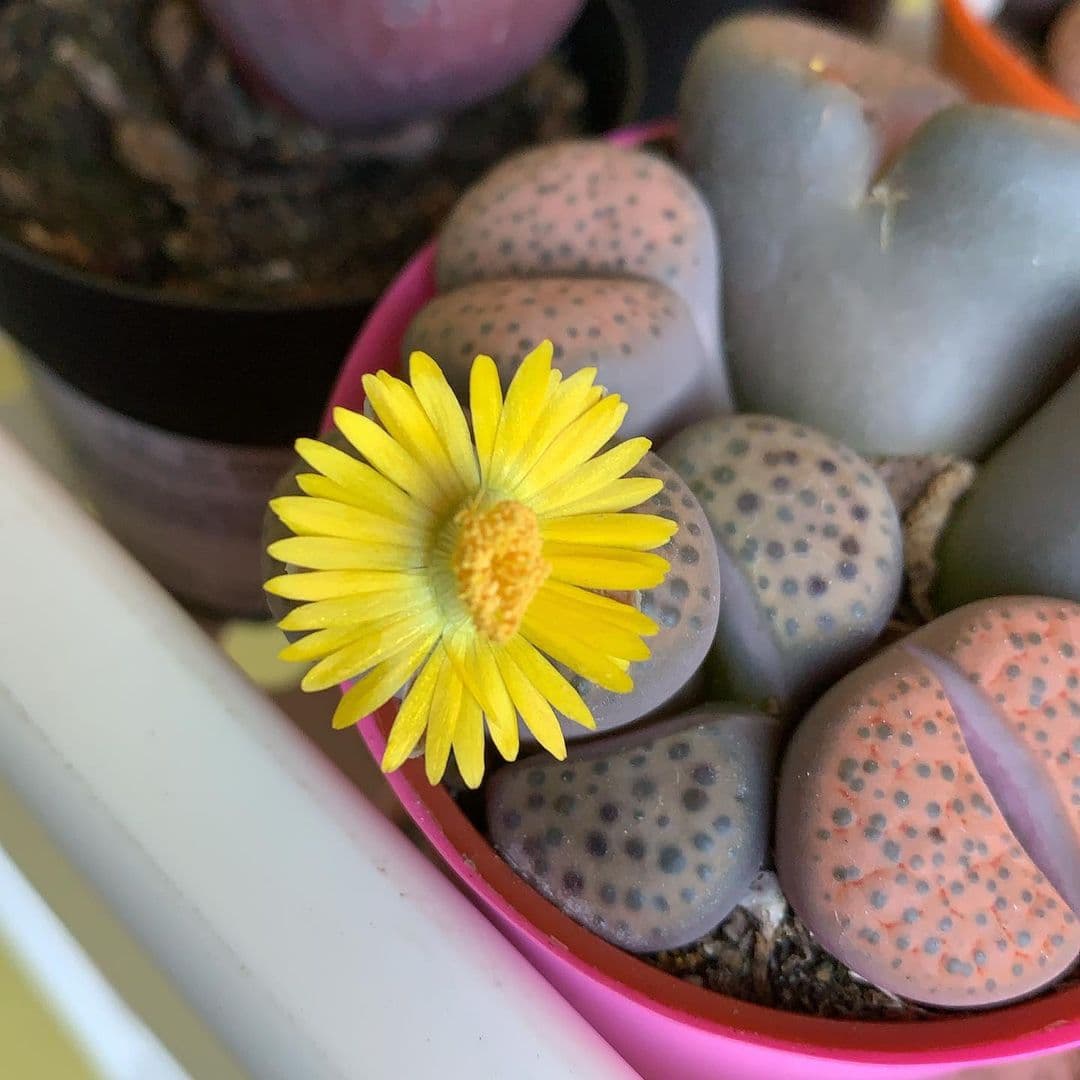Lapidaria Margaretae, aka. Karoo Rose
Posted by Grace on August 14, 2023
 Lapidaria Margaretae, aka, Karoo Rose
Lapidaria Margaretae, aka, Karoo Rose
Meet the Lapidaria Margaretae, a special succulent with a unique name and tough nature. We'll explore its story, how it looks, how to care for it, and how to make more of them.
Quick Facts
- Native Habitat: native to dry areas (250 mm per year) in southern Namibia, around Warmbad and the Northern Cape areas adjacent to Warmbad in South Africa 🇿🇦, at an elevation of 660 to 1,100 metres (2,170 to 3,610 ft) above sea level
- Family: Aizoaceae
- Water: Allow the soil to dry out almost completely between waterings
- Sunlight: full bright sunlight throughout the year
- Soil: white quartz plains, in crevices, in red sand or on loose stone
Contents
Why it is called Lapidaria Margaretae?
Lapidaria Margaretae belongs to a specific category of small succulent plants known as Lapidaria. It forms a monotypic genus within the Aizoaceae family, and its only member is the Lapidaria margaretae, also called the Karoo Rose.
The name "Lapidaria Margaretae" pays homage to the esteemed South African botanist, Margaret Esterhuizen, honoring her significant contributions to succulent plant research.
The Karoo, in the name of "Karoo Rose", also spelled Karroo, is an arid to semiarid geographic region located across the Eastern Cape, Western Cape, and Northern Cape provinces of South Africa. Karoo is a Bushman word for “dry place”
Appearance of Lapidaria Margaretae
Leaves
Unlike Lithops and Dinteranthus, which usually have just one pair of leaves, Lapidaria Margaretae has two to four pairs of leaves. Each leaf is around 1.5–2 cm long and 1 cm wide. As it grows older, it might form groups of up to three heads close together.
 Lapidaria Margaretae cluster
Lapidaria Margaretae cluster
Flowers
The Karoo Rose blooms with a yellow flower that's about 5 cm wide. This flower has about 6 or 8 parts on the outside and lots of petals – up to 100 of them! Inside, there are tiny parts called stamens, around 300 to 500. The flower opens during the daytime. Sometimes, there's one flower, and other times, you might see two more flowers nearby.
 Flower of Lapidaria Margaretae
Flower of Lapidaria Margaretae
Fragrance of Lapidaria Margaretae
While Lapidaria Margaretae is not typically known for its fragrance, the subtle scent of its blooms adds a pleasant surprise to its overall charm.
Toxicity
As with many succulents, Lapidaria Margaretae contains compounds that can be mildly toxic. However, the toxicity levels are generally low and seldom pose a serious threat to humans or animals.
For Humans
The sap of Lapidaria Margaretae can cause skin irritation in some individuals. It is recommended to handle the plant with care and wash your hands after touching it.
For Animals
While ingestion of Lapidaria Margaretae is not usually fatal for pets, it's advisable to keep the succulent out of their reach. Ingesting the plant can lead to mild gastrointestinal discomfort in animals.
How to Propagate Lapidaria Margaretae
If you're interested in multiplying your Lapidaria Margaretae plants, there are two primary methods you can try: using seeds or cuttings.
From Seeds
To propagate Lapidaria Margaretae from seeds, follow these steps:
-
Prepare the Soil: Fill a small pot with well-draining succulent soil mix. Ensure the soil is slightly damp.
-
Seed Placement: Gently sprinkle the Lapidaria Margaretae seeds evenly over the soil surface. Avoid burying them; instead, let them rest on top.
-
Mist the Soil: Using a spray bottle, mist the soil with water. This helps settle the seeds in place and provides the moisture required for germination.
-
Covering the Pot: Place a clear plastic lid or plastic wrap over the pot to create a mini-greenhouse effect. This maintains the necessary humidity levels for germination.
-
Germination Period: Keep the pot in a warm and bright location, but shield it from direct sunlight. Regularly check soil moisture and mist as needed to keep it damp, but not overly wet.
-
First Leaves: After a few weeks, tiny seedlings should emerge, showcasing their initial pair of leaves. This indicates that germination has taken place.
-
Transplanting: Once the seedlings have grown a bit and gained some stability, carefully transplant them into their own pots. Utilize a similar succulent soil mix and continue providing appropriate care.
Remember, nurturing plants from seeds requires time and patience, but it's a gratifying way to observe the entire lifecycle of your Lapidaria Margaretae.
From Cuttings
Alternatively, you can propagate Lapidaria Margaretae through cuttings. However, this method is more intricate due to the plant's slow growth and susceptibility to rot. For higher success rates, focusing on seed propagation is recommended.
Whether you decide to propagate from seeds or cuttings, experimenting with both techniques can be an enjoyable way to deepen your understanding of this distinctive succulent while relishing the journey of cultivating new plants.
Care Guide For Lapidaria Margaretae
Light
They love having lots of bright sunlight all year round, and they can grow whenever the weather is warm and sunny, and there's water around.
Watering
Allow the soil to dry out almost completely between waterings. Overwatering can lead to root rot, so it's crucial to maintain a balanced watering routine.
Soil
Lapidaria margaretae grows on white quartz plains, in crevices, in red sand or on loose stone.
Temperature
They enjoy full, bright sunlight all year round. They can grow whenever it's warm, sunny, and there's water. Also, these plants can handle cold temperatures down to −4 °C (25 °F) without any problem.
Humidity
Low to moderate humidity levels are suitable for this succulent. It is well adapted to arid conditions.
Fertilizing
Feed your Lapidaria Margaretae with a diluted, balanced liquid fertilizer during the growing season (spring and summer). Avoid fertilizing during the dormant period.
Pruning
Remove any dead or dried leaves at the base of the plant to maintain its neat appearance.
Repotting
Repot the succulent every 2-3 years or when it outgrows its current container. Spring is the ideal time for repotting.
Dormancy
The plant is mostly dormant during the hot summer and cold winter, only growing during the spring and autumn. It also produces flowers in the later part of autumn or sometimes in early winter.
Pests and Diseases
While Lapidaria Margaretae is generally resilient, it can still fall victim to common succulent pests like mealybugs and aphids. Regularly inspect your plant for any signs of infestation.
Need tools for succulent propagation and repotting? Here are my go-to tools: mini tool set (including syringe 💉, gloves 🧤, tweezers 🪤, dust blower 💨, tiny shovels 🛠️) and well-draining mix 🌱.Common Problems of Lapidaria Margaretae
Pests
These tiny insects can hide in the crevices of the leaves and cause damage. Use a mild soap solution to gently clean the affected areas.
Diseases
Overwatering can lead to root rot, causing the plant's health to deteriorate. Ensure proper drainage and a well-draining soil mix to prevent this issue.
Where to find Lapidaria Margaretae?
Lapidaria Margaretae can often be found in specialized local and online nurseries that focus on succulent and cactus varieties. Additionally, online plant marketplaces and botanical garden sales can be good sources to acquire this unique succulent.
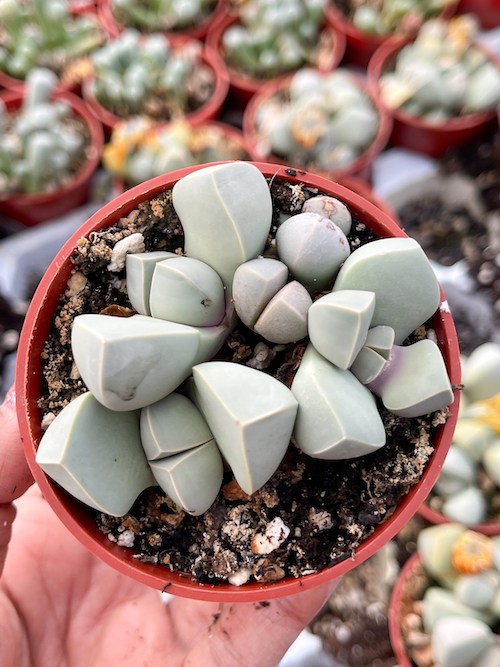 Lapidaria Margaretae is being sold on an Esty shop
Lapidaria Margaretae is being sold on an Esty shop
FAQ
Can I keep Lapidaria Margaretae indoors?
Yes, you can keep it indoors, but make sure it receives sufficient light. Placing it near a sunny window is recommended.
How often should I water Lapidaria Margaretae?
Water when the top inch of the soil feels dry. Frequency depends on environmental conditions.
Is Lapidaria Margaretae suitable for beginners?
Yes, its relatively low-maintenance requirements make it a good choice for novice succulent enthusiasts.
Final Words
So, there you have it – the Karoo Rose, your new succulent buddy! Whether you're a green-thumbed pro or just starting your plant journey, this little gem will brighten up your space and put a smile on your face. Happy planting! 🌱

